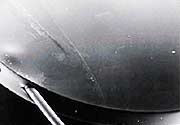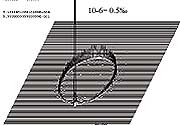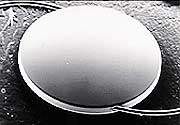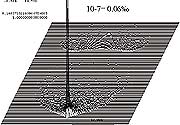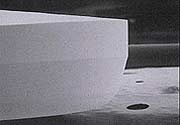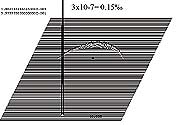OptiEdge design has dual function
AMO’s OptiEdge is designed to reduce edge glare with a rounded anterior edge, while preventing PCO with a squared posterior edge.
SAN FRANCISCO — Advanced Medical Optics’ Sensar acrylic IOL with OptiEdge technology may be a viable option for both reducing problematic edge glare and minimizing epithelial cell migration, according to a surgeon speaking here.
“The features of the Sensar IOL make it an attractive alternative to square-edged IOLs,” Samuel Masket, MD, said here at the meeting of the American Society of Cataract and Refractive Surgery.
According to Dr. Masket, dysphotopsia — edge glare — is the “tradeoff” of the square-edged IOL design that has been shown to reduce the occurrence of posterior capsule opacification (PCO).
Square-edge tradeoff
Square-edged IOLs prohibit the migration of epithelial cells and subsequent PCO, Dr. Masket noted.
“The square-edged IOL is significantly valuable for reducing PCO,” Dr. Masket said. “This is understood clinically because the bent angle prohibits spread and proliferation of lens epithelial cells in the posterior capsule.”
However, with the advantages of a square-edged IOL come disadvantages, Dr. Masket said. In the 1990s, surgeons discovered that oblique light striking at the truncated square edge of an oval lens is responsible for undesirable optical effects, he said.
Such effects, he said, have been “troublesome” for patients in his office.
“Patients may interpret them as glare, halo, arcs and rings,” he said.
| ||||||||
Dysphotopsia
Dysphotopsia is a term coined by Randall Olson, MD, to describe the internally reflected edge glare.
According to Dr. Masket, there have been several theories on the cause of dysphotopsia.
“One school says that oblique light striking the internal aspect of the square edge would be responsible for internally reflected light,” Dr. Masket said. This creates a virtual image near the central part of the retina, he explained.
Another possible explanation for dysphotopsia is reflection from the surface of the lens curvature, he said.
“Some researchers, in particular Jay Erie, think that near-axis light, reflected on the foveal region, is to blame. In this instance, light will reflect off the posterior surface of the anterior curvature of the IOL,” Dr. Masket noted.
Dr. Masket said multiple features of lens design may contribute to edge glare.
“At the end of the day, all features are important,” he said. “Square-edged design, index of refraction and radius of curvature all play a role in causing positive dysphotopsia.”
Dr. Masket said additional factors that may trigger dysphotopsia are corneal curvature, pupil size, capsule overlap, size of the optic and depth of the posterior chamber.
“The challenge we are faced with now is how to limit edge-induced dysphotopsia while preventing PCO,” he said.
Developing OptiEdge
Approved for use around the world, including the United States and Japan, the Sensar IOL with OptiEdge has demonstrated a reduction of dysphotopsia and PCO in clinical trials, he said.
The OptiEdge design incorporates a posterior square edge to avoid epithelial cell migration and a rounded anterior edge to reduce the occurrence of dysphotopsia.
“To design the technology, AMO researchers used a non-sequential ray tracing analysis to look at what would happen to the fate of bundles of light passing near the edge,” he said.
According to Dr. Masket, researchers analyzed different square-edged, round-edged and combination designs with ray tracing analysis at oblique light in different angles of deflection. They found square-edged IOLs to be responsible for a greater degree of internal, reflected glare than either round-edged or combination models, he said.
Reducing dysphotopsia
The work of Alessandro Franchini, MD, echoes these findings, Dr. Masket said. “Dr. Franchini demonstrated that with round, square and OptiEdge, there’s a difference in the amount of reflected light and induction of potential glare,” he said.
“We know that this edge design works with the Clariflex silicone material. It’s likely that it also will work with acrylic and, therefore, produce less dysphotopsia,” Dr. Masket said.
He noted, however, that the level of dysphotopsia reduction is a difficult factor to measure because surgeons “rely so heavily” on subjective patient responses.
“Unfortunately, we really don’t have a way, clinically, to measure the dysphotopic complaints in patients. So, it is somewhat difficult to really bring this to good science,” he said.
For Your Information:
- Samuel Masket, MD can be reached at Advanced Vision Care, 2080 Century Park East, Suite 911, Century City, CA 90067; (310) 229-1220, fax: (310) 229-1222. Dr. Masket is a consultant for Advanced Medical Optics.
- Advanced Medical Optics, makers of the Clariflex and Sensar IOLs, can be reached at 1700 E St. Andrews Pl, Santa Ana, CA 92799; (800) 449-3060; fax: (866) 872-5635; Web site: www.amo-inc.com.

